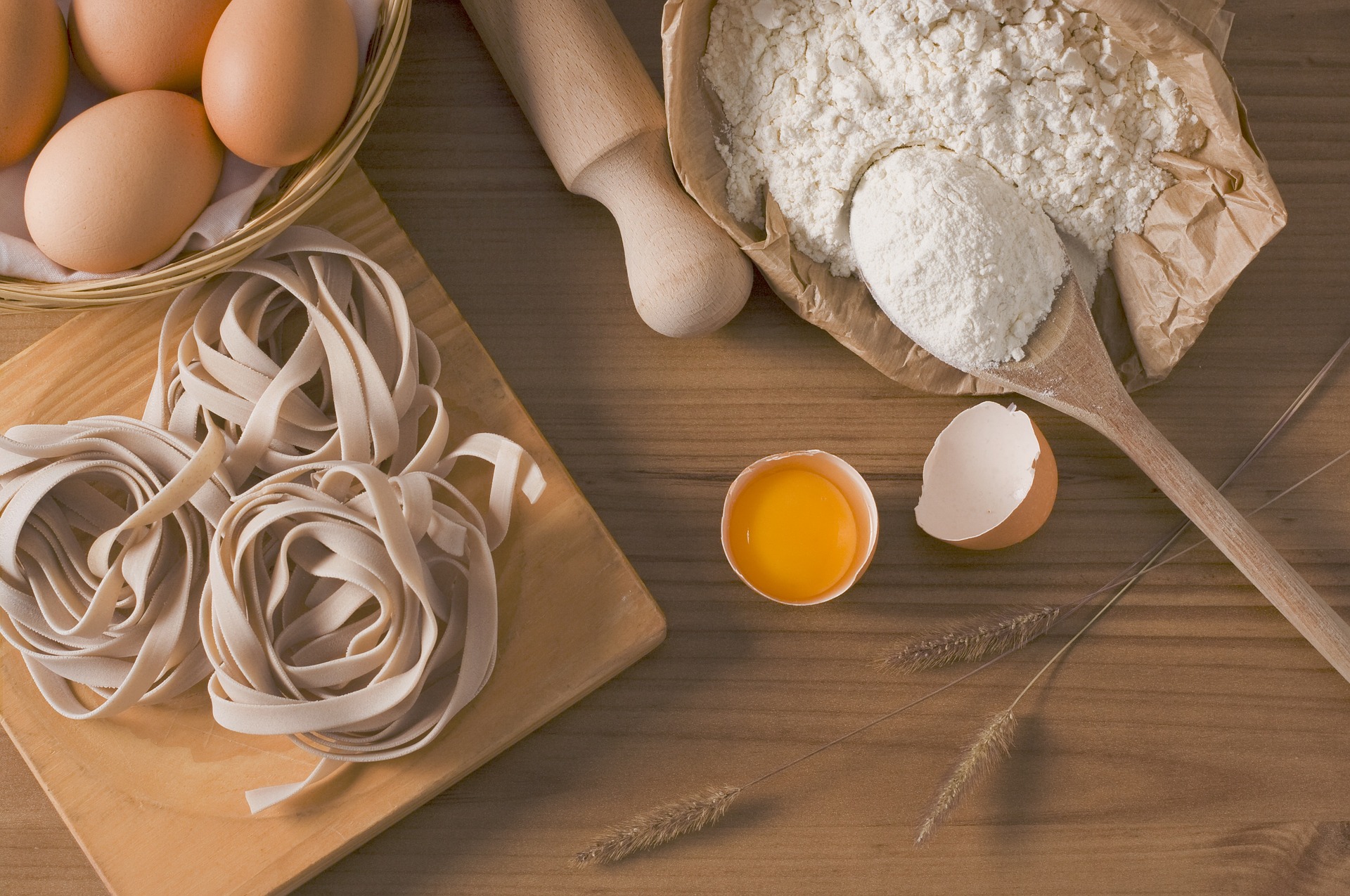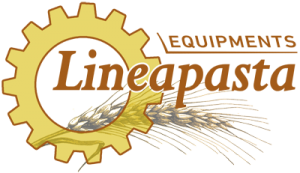Pasta machines
Pasta is undoubtedly the main food of Italian cuisine. Known all over the world, it is proposed in the market in different types, but the best one is always the one made at home. It is very easy to prepare and very few ingredients are enough: water, flour and, optionally, eggs or other additional ingredients.
More and more nowadays we use automatic machines with engines both in work and at home, but why? Here below you can find couple of information and suggestions to let you enter the world of pasta with some basic concepts explained in the essential.
Structure of a pasta machine
As we will see in detail later, the pasta machine is really simple to use; you will be able to quickly and effortlessly produce many long and short pasta shapes, pasta sheet to be used for the preparation of lasagna or ravioli and, on some models, even gnocchi.
The basic structure of a machine is also very simple and can be divided mainly into 3 parts:
Machine’s body, equipped with a built-in motor.
The motor voltage is a very important choice for the correct operation of the machine. Motors in 50 or 60 Hz, single-phase or three-phase are available. Always contact your trusted electrician who, depending on the line installed in your laboratory. will guide you through the correct choice of the motor for your pasta machine.
Cylinder
At the front of the machine you will find the extrusion tube, from which the pasta will come out in different formats, depending on the mounted die.
On some models, such as on the Monferrina P6 or P12, on the extrusion tube there is a plastic sleeve with two holes that allows fresh water to flow inside to avoid overheating. In fact, an extrusion tube that is too hot will risk ruining the dough, especially if the dough contains eggs. It is therefore important to opt for a machine with this feature if your intention is to work for several hours without interruption.
Buttons and security systems
The machines are equipped with a few but basic buttons: the on /off button, the button for kneading/extruding and, depending on the models and the matching accessories, the knob to adjust the rotation speed of the knife, to adjust the amount of stuffing in ravioli etc.
Each machine is equipped with safety systems to prevent any type of accident. If the covers are not properly closed or the accessories are not correctly installed, the machine will not switch on, thus preventing you from accidentally damaging any part of the machine.
Extrusion machines, laminators and combined machines
What is the difference between these models?
The extrusion machines (commonly called “presses”) work by pushing the dough through the perforated discs (dies) mounted on the machine which, depending on the number of holes, the thickness, the size, etc., produce different sizes of pasta, long or short.
As we will see further on, for the short pasta it is possible to mount an automatic rotary knife on the machine which will speed up and facilitate the cutting, allowing you to temporarily leave the machine and let the knife do its job.
The laminating machines, on the other hand, are made up of rollers of different sizes that allow the dough to be rolled, adjusting the thickness at will through a small lever.
For laminating machines there are several accessories that can be combined to cut the dough more or less wide, going to easily create noodles, tagliolini, pappardelle, etc. For Monferrina machines it is also possible to choose the jagged edge cut.
Finally, the combined machines are those machines that allow the installation of additional accessories to add new types of production, such as the Monferrina P.nuova, a laminator that allows the installation of a press unit for the production of extruded pasta.
Easy to use
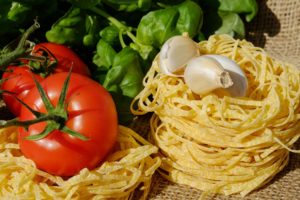
The pasta machines work through a very simple process: insert the ingredients into the kneading tank, an arm called “mixing shaft” will mix all the ingredients creating a crumbly and homogeneous dough, ready to be extruded.
At this point, the screw on the base of the kneading tank called “cochlea”, will push the dough through the die, creating the desired pasta format depending on the die used.
The machines are all easy to disassemble for a thorough cleaning and all the parts of the machine in contact with the pasta are made of stainless steel to ensure maximum hygiene.
Ease of clean
With a very simple structure, pasta machines are also extremely easy to clean. Simply remove the cochlea and the screw to easily access the mixing tank.
Cleaning products must not be used. It is enough to use a cloth soaked in water immediately after use, in order to remove all the residues of fresh pasta: if the pasta will dry out, it will be much more difficult to clean the machine, so we always recommend a thorough cleaning after each use.
Accessories and dies
For all the machines, there are various accessories available, such as the knife to automate the cutting of the short pasta, and the dies, which give the pasta its shape.
The knife is able to cut only the short pasta sizes (for the long pasta shapes you will have to cut it by hand); it is adjustable in speed allowing to obtain medium-length pasta such as fusilli, caserecce, penne, etc. but also very small pasta to be used in broths or soups.
The dies are available in two versions: bronze or PTFE. The bronze dies are the most common ones, producing a rough and porous pasta, perfect for collecting the sauces. The PTFE version dies instead, produce a smoother and more glossy pasta. It is therefore important to choose the right dies according to the type of pasta you want to obtain.
Some machines allow the insertion of accessories such as the Multipasta, which allows you to produce ravioli with interchangeable molds, gnocchi or the cutting unit that allows you to cut vertically the dough produced with the machine, producing different sizes of long pasta depending on the thickness of the cut: tagliatelle, fettuccine, pappardelle etc.
Ravioli production
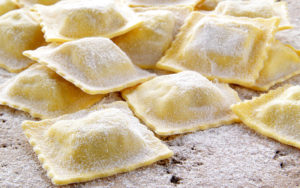
Making ravioli can be a long and tiring job, but using a pasta machine it becomes easier.
There are several solutions for making ravioli: the most economical solution is to spread the pasta sheet by hand and use a manual ravioli machine. It will therefore be necessary to prepare the pasta sheet of the right width, prepare the filling and assemble everything on the manual ravioli machine, which will be activated by turning the appropriate handle.
Another solution is to produce the pasta sheet using the special pasta sheet die and then use it on a ravioli machine (which can be manual or electric). With the electric ravioli machine, the machine will do everything by itself and the ravioli must be simply detached from each other.
Through a screw placed on the pasta sheet die, it is possible to change the thickness by creating a very thin sheet suitable for the production of different types of filled pasta.
What are the advantages of using a pasta machine?
– By producing the pasta yourself you will be sure of the goodness and genuineness of the ingredients used compared to what you find on the market; this is an aspect definitely not to be underestimated for those who are celiac, have an intolerance, an allergy or have chosen a vegan diet.
– For those who love fresh pasta and buy it regularly, using a machine will significantly reduce production time and cost but definitely increasing its quality.
– It is much simpler to leave the task of cutting short pasta shapes with the rotary knife, in this way you can dedicate yourself to something else without having to stad beside the machine.
– Creating the pasta sheet using the power of an engine is much faster and easier than rolling it by hand with a rolling pin.
– It is possible to make different shapes of extruded pasta in a few minutes, only by changing the die on the machine.
Recommended machines
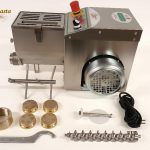
Monferrina Dolly
La Monferrina Dolly is a small countertop machine, compact and reliable; it is suitable both for restaurants and for people who like good home-made pasta. It can knead by using any kind of flour and it produces long and short pasta shapes changing the die.
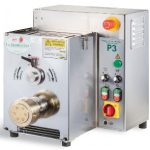
Monferrina P3
La Monferrina P3 is an automatic and very reliable machine, suitable for working with any kind of flour and durum wheat (semolina); it is suitable for long and short pasta shapes production which can be obtain by simply changing the extruding die.
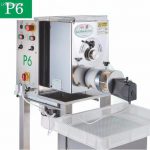
Monferrina P6
La Monferrina P6 is an automatic and very reliable machine, suitable for working with any kind of flour and durum wheat (semolina); it is suitable for long and short pasta shapes production which can be obtain by simply changing the exstruding die.
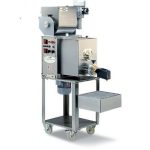
Monferrina P12
La Monferrina P12 is an automatic and very reliable machine, suitable for working with any kind of flour and durum wheat (semolina); it is suitable for long and short pasta shapes production which can be obtain by simply changing the exstruding die.
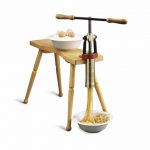
Bottene Bigolaro
The Hand extruder for Bigoli Bottene is a tool for hand made fresh pasta making of various types: rigatoni, spaghetti, tagliatelle and tagliolini.
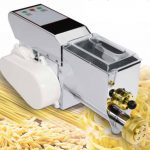
Bottene Lillodue
Bottene Lillodue, a domestic appliance manufactured to the same technical features and with the same robust performance as those machines supplied to larger restaurants and commercial enterprises.
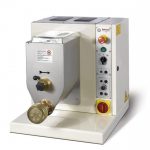
Bottene Inver 3
Bottene INVER 3 is a strong pasta machine, practical and simple to use. It is possible to produce various type of fresh pasta with any type of flour, with or without eggs and even coloured pasta: red with tomato, green with spinach, brown with cocoa etc
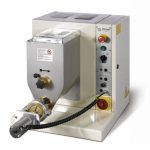
Bottene Inver 7
Bottene INVER 7 is a strong pasta machine practical and simple to use . It is possible to produce various types of fresh pasta with any type of flour, with or without eggs and even coloured pasta: red with tomato, green with spinach, brown with cocoa etc.
Where to buy?
Lineapasta is a company founded in 2009 with one big goal: to create the largest international online supply market for pasta operators. The purchase of equipment for the production and treatment of pasta is complex and requires a professional figure to help you and follow you in your choices, Lineapasta is committed to advise you and help you step by step in all the choices that will help you produce the best pasta.
The final consumer is demanding and the high quality of the pasta is determined only thanks to professional equipment that can fully exploit the skills and qualities of the ingredients. Lineapasta has selected only quality equipment whose reliability has been proven over time. All the equipment is chosen and offered to customers to offer the best value for money.
Purchase orientation service:
A pre-sales consultancy service is almost never offered on the Internet and very few retailers are professionals able to provide technical advice from industry experts such as the Lineapasta team. Even before the purchase you can count on pasta technicians, to get directions and suggestions for the correct purchase of products that will meet your specific needs. They will help you select the necessary products, guiding you through the order process and monitoring your shipment to ensure that the goods are received safely and in the shortest possible time.

